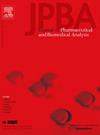Study on the mechanism of Xinmailong injection against chronic heart failure based on transcriptomics and proteomics
IF 3.1
3区 医学
Q2 CHEMISTRY, ANALYTICAL
Journal of pharmaceutical and biomedical analysis
Pub Date : 2024-10-18
DOI:10.1016/j.jpba.2024.116529
引用次数: 0
Abstract
Xinmailong (XML), a traditional Chinese medicine derived from Periplaneta americana, is commonly used in China to treat chronic heart failure (CHF). However, its pharmacological mechanism remains unclear. In our research, we employed Doxorubicin (Dox) to create a CHF animal model and administered XML treatment to investigate the pharmacological effects of XML on CHF rats by combining transcriptomic and proteomic analyses. XML improved dox-induced CHF and improved cardiac function, and a joint multi-omics analysis demonstrated that it reduced cardiomyocyte fibrosis during CHF. There is further evidence that XML may alleviate cardiomyocyte fibrosis through its effects on the cGMP-PKG signaling pathway or by reducing the expression levels of COL1A1, COL3A1, MMP9, and CXCR2. In this study, the effects of XML on rats with CHF are examined at the transcriptional and protein levels, as well as its mechanism and mode of action in treating CHF. There may be novel therapeutic targets or clinical indications for XML-based CHF therapy resulting from the study's identification of significant differential genes and signaling pathways.
基于转录组学和蛋白质组学的欣麦隆注射液防治慢性心力衰竭的机制研究
新麦隆(Xinmailong,XML)是一种从美洲长春花(Periplaneta americana)中提取的传统中药,在中国常用于治疗慢性心力衰竭(CHF)。然而,其药理机制仍不清楚。在我们的研究中,我们利用多柔比星(Dox)建立了一个CHF动物模型,并给予XML治疗,通过结合转录组学和蛋白质组学分析,研究XML对CHF大鼠的药理作用。XML改善了Dox诱导的CHF并改善了心脏功能,一项多组学联合分析表明,XML减少了CHF期间的心肌细胞纤维化。有进一步的证据表明,XML 可通过影响 cGMP-PKG 信号通路或降低 COL1A1、COL3A1、MMP9 和 CXCR2 的表达水平来减轻心肌细胞纤维化。本研究从转录和蛋白质水平研究了 XML 对慢性心力衰竭大鼠的影响及其治疗慢性心力衰竭的机制和作用模式。通过本研究发现的重要差异基因和信号通路,基于 XML 的慢性心力衰竭疗法可能会有新的治疗靶点或临床适应症。
本文章由计算机程序翻译,如有差异,请以英文原文为准。
求助全文
约1分钟内获得全文
求助全文
来源期刊
CiteScore
6.70
自引率
5.90%
发文量
588
审稿时长
37 days
期刊介绍:
This journal is an international medium directed towards the needs of academic, clinical, government and industrial analysis by publishing original research reports and critical reviews on pharmaceutical and biomedical analysis. It covers the interdisciplinary aspects of analysis in the pharmaceutical, biomedical and clinical sciences, including developments in analytical methodology, instrumentation, computation and interpretation. Submissions on novel applications focusing on drug purity and stability studies, pharmacokinetics, therapeutic monitoring, metabolic profiling; drug-related aspects of analytical biochemistry and forensic toxicology; quality assurance in the pharmaceutical industry are also welcome.
Studies from areas of well established and poorly selective methods, such as UV-VIS spectrophotometry (including derivative and multi-wavelength measurements), basic electroanalytical (potentiometric, polarographic and voltammetric) methods, fluorimetry, flow-injection analysis, etc. are accepted for publication in exceptional cases only, if a unique and substantial advantage over presently known systems is demonstrated. The same applies to the assay of simple drug formulations by any kind of methods and the determination of drugs in biological samples based merely on spiked samples. Drug purity/stability studies should contain information on the structure elucidation of the impurities/degradants.

 求助内容:
求助内容: 应助结果提醒方式:
应助结果提醒方式:


